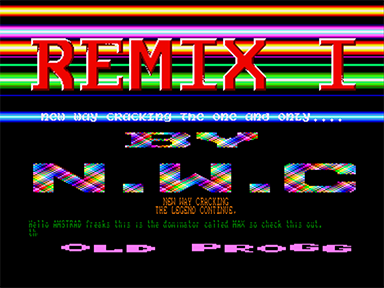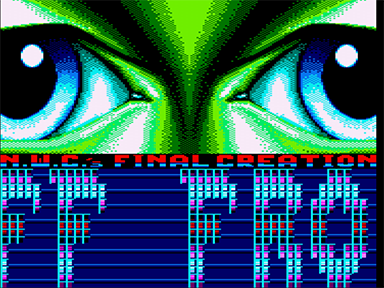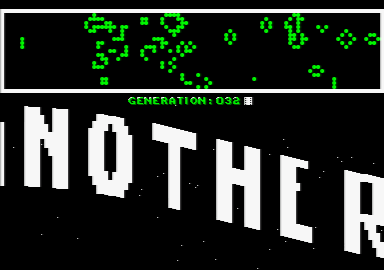New Way Cracking's importance in the CPC demoscene history has been largely underestimated, although he was the first to do fullscreen, hardware scrolling and classical splitting in a demo! An interview was needed to correct this injustice...
Hicks – Hello Peter! Can you introduce yourself and describe how everything started for you on CPC? It seems that you began by cracking games then by doing demos?
NWC - About myself; I live in the northern part of Denmark with my girlfriend and her 9 years old boy, today some 30km north-east of Aalborg. Back in the CPC days I lived in south-west part of Aalborg with my parents (both dead now), where I was born in 1970. Today I'm not doing any demo coding, whenever I program in my spare time, it's usually in C or Python for either Arduino or Raspberry Pi hobby projects. Mostly useful things like logging data from my solar inverter, or a fan controller and logging temperatures from my sport car (Lotus Elise). Professionally I hold an M.Sc.E.E and are working with developing FPGA code for test equipment to cell phones.
 My computer interest actually started circa two years before I got my CPC, one of my friends (MAX in Worldwide Crap, Remix-I and other of my early demos) had got a Power 3000 during the summer of 1982. For those who don't know; a Power 3000 is a Taiwanese clone of the Sinclair ZX81, but with 2Kb memory instead of 1Kb, and it also has one channel sound!
My computer interest actually started circa two years before I got my CPC, one of my friends (MAX in Worldwide Crap, Remix-I and other of my early demos) had got a Power 3000 during the summer of 1982. For those who don't know; a Power 3000 is a Taiwanese clone of the Sinclair ZX81, but with 2Kb memory instead of 1Kb, and it also has one channel sound!
MAX and I had fun trying to program it in BASIC, we were very young, MAX around 9 years and I was 11 years. When Christmas 1982 came, I got a Lambda 8300, which is the same machine as a Power 3000, just a different colour/brand. There were not much software around for it, so I mostly used it for programming my own stuff; simple games. Later I also made a bit of hardware for it, mainly re-boxing it and adding a PPI to control the stopping of the tape recorder. Yes, it was those 'wonderful' days of the very unreliable ZX81 tape interface.
My Amstrad CPC career started in the summer of 1985. As my older brother needed a word processor for his education, he brought a CPC 464, and I was so lucky I could lend it for the summer holidays. I discovered that the CPC had (and still has...) an extremely powerful BASIC, a much more reliable tape interface than ZX81, and in general was a great computer.
I decided that I would try to get the money for such a beast. So it was very lucky, and sort of coincidence that I didn't buy a Commodore 64... Because if my brother had not brought the CPC, I would probably have followed the mainstream at that time and brought the Commodore 64... Like MAX already had...
Then one day, or more precise, on the 16th of September 1985, I had enough money for a CPC 664 with a colour monitor - Yes, the collector's item today... At the instant I got it, I started to program it. The first year or so passed by with programming in BASIC, and a bit of tape-to-disc transferring. At that time the CPC 464 was the most popular CPC, and most games were on tape, so I had to transfer them to disc and remove the lame protections.
As I had no knowledge of assembler language, it was only the very simple protections I could remove and the protections were evolving rapidly... During that period I was using different names, both as cracker and programmer, but mostly I used "664-Cracking". In the very early days I did demos and programs in BASIC only. It wasn't until around October 1986 I started to use the "New Way Cracking" name, around the same time I started to learn z80 assembly language. When I started to learn assembly, I found looking into other people's code quiet boring, so cracking was never something I did much, I much preferred to do my own stuff.
I have tried to list ALL my work and dates in the attached PDF, and some comments to some of the stuff, obviously it is not complete, some has been lost during the last 33 years...
Hicks – Can you depict us the state of the danish demoscene at this time (1987-1989)? Who were your main contacts in Denmark? I think the UAC (United Amstrad Crackers) group was one of the first groups, probably alongside with JLCS and Tyronesoft?
NWC - My first contact was Tyronesoft, around February 1988, it turned out that he lived some 20km from where I lived, so we met. My other contact who had some coding skills were Dizzy from UAC, although he lived some 300km from me, we met one summer, when he was on vacation in the part of Denmark where I live.
I never really had contact with JLCS, even if we were in the same group (UNIX) at some time. I met JLCS at the BMC European Demo Party in Mettingen 1991. I also had some other contacts; The Bomber, Mr. Lou, PMH, and some others which I never met.
At the time I started coding demos, many of the Danish crackers had already, or was leaving the CPC, names like; LFS, Deltatronic, 007, Mr. Watson, ZOD, ABC, Underware, DAC and DAX were what I think of as the "first wave" of Danish crackers, a bit later UAC and especially JLCS was dominating the Danish cracking scene.
There are a few demos from the very early period, who was done by someone with assembly coding skills, which I remember:
In the eighties I had no contacts outside Denmark.
Hicks – Your first demos on Amstrad are from the middle of 1987, and you can be considered as the grandfather of demomaking on this platform! Where did you find your inspiration (games, cracks, other computers)? Do you remember having seen other demos on CPC before your first?
NWC - I got much inspiration from seeing demos on the C64 at my friend MAX, at that time I would never have guessed that the demos on the CPC would evolve to be just as amazing as they already were in the mid/late eighties on the C64. I had not seen demos on the CPC before I made my first demo, as I didn't get any scene contacts (Tyronesoft) before around February 1988.
 Hicks – Some guys argue that your first demos, like Remix-I, was backdated, which means that the release date announced in the demo (march 1988) was much earlier that the real release date. Is this true or only rumor? Can you remember the release date of your Final Creation demo?
Hicks – Some guys argue that your first demos, like Remix-I, was backdated, which means that the release date announced in the demo (march 1988) was much earlier that the real release date. Is this true or only rumor? Can you remember the release date of your Final Creation demo?
NWC - This is not true; I have not back-dated demos. I think the rumor was spread by Longshot in "The Demo", because I do check for Multiface-II already in "Thanks-Dizzy" (12-3-1988), and Longshot was of the opinion that there were no Multiface-II around at that time. But there were, my Multiface-II is from 1986 (Pressing f0 in the Multiface menu, and it will write the year 86)... Another possible reason for the rumor is that it took sooo long time before my demos were spread in the start, as I had no contacts before start of 1988. As anybody can see in TNT Demo and The Final Demo, I get greetings/messages about my Final Creation - so those who think I backdated my early demos, must also think I back-dated their demos - quite ridiculous?!
My Final Creation was released 7-6-1988.
Hicks - So, Remix-I (march 1988) features the first hardware scroll in a demo, and we can consider that Final Creation (june 1988) features the first splitting and fullscreen in a demo too! How did you discover these techniques, particulary screen splitting? Did you have a look at games like Mission Genocide?
NWC - Hardware scroll wasn't terrible difficult to figure out; it's even used in BASIC for scrolling up and down. Even very early games like Roland on the Ropes and Roland in the Caves use four directional hardware scroll.
So I simply played around with the CRTC in BASIC to figure out what could be done with all those CRTC registers - I had got the book "CPC 664/6128 Intern" (Data Becker) for Christmas 1986 - A very bad Danish translation of the original German book, however, in this book there were some description of all chips inside the CPC...
So it was obvious it could be used for a scroll text too. The most difficult part was figuring out the addressing when the screen wraps, it´s a bit complicated. The parallax effect is done by palette colour shifting, so that looks like the bars are scrolling slower than the text. Actually the scroll in Remix-I also shows "full-screen", but it's cheating, as the top/bottom is the same - this is the reason the scroll text isn't even higher :-D.
About the split; you're spot on! - I was very amazed by the very smooth (and slow) vertical scroll, and at the same time the big "scoreboard" staying rock solid at the bottom of the screen. Other early games with hardware scroll, e.g. Thing on a Spring and Legend of Kage, usually had a very small "score board" (re-drawn by software every frame) or no scoreboard at all.
So I looked into the code of Mission Genocide, and found out how it was done. From that knowledge I made the split in Final Creation - only the main part with the eyes from The Sentinel is a "real" split. The Copy-Chain part is made before I discovered splits, and done in a different way. They are a mix of soft- and hard-ware scrolls.
A funny thing I was surprised to discover in Mission Genocide, when I looked into the code, is that the split is driven by a "fast ticker" firmware interrupt. It wasn't even done by a direct z80 interrupt - the firmware is still active while the game is running...
Hicks – Can you remember which demos you received when you were active? Who were your main contacts outside Denmark? Swapping was crucial to spread your demos and receive others' ones I guess...
NWC - WoW, I can't remember which demos I got when I was active, it was a lot! - In the end I had 889 demos... - and that’s very precise, as I put all my software into a database program I made, so that when swapping, my contact could see what he wanted. I still got the database… and I transferred all my CPC discs to PC back in 2011.
My absolutely best contact in to/out of Denmark was Black Mission Cracking (BMC). I got a LOT of demos and games trough him. But I also had contact with Longshot, Weee!, Elmsoft, Warlock and some in UK.
Hicks – You stopped your activities a first time around 1989, then you came back with Not Dead in 1990. Can you tell us why did you stop and then came back? You were working on games at this time, weren't you?
NWC - I stopped because I was working on a game from 20/8-1988 to around March 1989 together with Tyronesoft. We tried hard to get some companies to publish it, but no one would. It was named WyZaxx, and was a vertical scrolling shoot'em-up game, using hardware scroll. Since the CPC marked was dying, and I had no contacts outside Denmark, I didn't see much point in staying on the CPC, everybody was moving to the Amiga... So I decided to buy one too.

During the period I had Amiga, Code Masters asked me if I would do a conversion from Commodore 64/Spectrum of their game "Rally Cross", to the CPC. I accepted. At the same time the Amiga hardware kept failing for me, so I finally got my money back. The complete Amiga-failure story is written in "Not-Dead" scroll text, so will not bore you with it here. Also I began to get contacts from outside Denmark, too. So suddenly CPC was interesting again, and I was back on CPC!
In order to get a break on the game coding, I made Not-Dead demo. And when Code Masters in the end was not willing to give us a contract, we stopped working on the Rally Cross game on the 28-8-1990. None of the games was ever finished. In both cases Tyronesoft did the graphics and I did the code. So instead we started on Unique demo...
Hicks – Can you tell us how and when you joined the UniX group? Which projects did you start together?
NWC - I don't remember the exact date/year, but I know it was before the BMC European Demo Party in Mettingen 1991. One of my contacts; Warlock or Asterix, don't remember, asked me if I wanted to join a group, and that was ok with me. We really did not start anything; I think that maybe I got some graphics for Unique demo, but not sure.
 Hicks – It seems that there is a long story behind the release of Unique Megademo! I believe that the main routines were coded in 1993-1995, but the final demo was released only in 1998. Some parts are still very solid, like "Not Dead II" or "Globe Scroll"!
Hicks – It seems that there is a long story behind the release of Unique Megademo! I believe that the main routines were coded in 1993-1995, but the final demo was released only in 1998. Some parts are still very solid, like "Not Dead II" or "Globe Scroll"!
NWC - Most of Unique was coded between 1990 and 1993; it was released 18-10-1997. When the Rally Cross project failed in August 1990, Tyronesoft and I started the Unique demo project. I showed two parts on the BMC European Demo Party in Mettingen 1991; The-Plot! and 4-Sins, and also the Noiseload music-disc-loader system was ready back then. The sinus scroll routine for the 4-Sins part is based on the scroll in my Not-Dead demo. The 4-Sins part is the first part I made for Unique. In September 1993 I started on University (Tyronesoft had started already in 1992, I think), and so we had no spare time for CPC coding...
In the next years I used some of my summer holidays to finalize the parts, until I could finally make the release in 1997. Strangely, I can't find that date anywhere in the demo, but I made a label for my disc, where the date is written. I still got the Corel Draw file! - I had long time before Unique was released moved to PC/Windows...
There were planed a few more parts, where I have already made some of the code/ideas, but they have never been finished or released. Back then I did not have the time for finalizing them. I also found that there was no space for more parts on a single disc anyway.
 Hicks – When you finally stopped you activities after Unique, did you have unfinished projects left? Did you stop all your demomaking activities or move to another platform?
Hicks – When you finally stopped you activities after Unique, did you have unfinished projects left? Did you stop all your demomaking activities or move to another platform?
NWC - Yes, there are unfinished Unique parts, and ideas, but I have never finalize them. I did not move on to do demos on other platforms. After university I was "hit" by job, house, family, life... you know, the curse of growing up - don't do it, it's a trap :-D
Hicks – Are you still curious about the Amstrad demoscene or demoscene in general? If so, what is your feeling about it?
NWC - Once in a while I go to youtube and search for CPC demos, and I'm very amazed of both the quality and techniques that are presented - and also that there are still people that do games and demos for the CPC.
Hicks – Thank you very much, it was moving for me to write this interview, you're a "legend of the future"!
NWC - You're welcome; I was quite surprised and proud to see the greeting / message in Onescreen Colonies (Vanity) demo.
/Peter Sørensen aka NWC 3-9-2018.
Download the complete list of NWC CPC produtions
Download NWC's demo collection